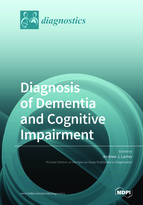Diagnosis of Dementia and Cognitive Impairment
A special issue of Diagnostics (ISSN 2075-4418).
Deadline for manuscript submissions: closed (30 June 2019) | Viewed by 52704
Special Issue Editor
Special Issue Information
Dear Colleagues,
Dementia and cognitive impairment represent one of the most pressing clinical and social issues of our time, issues likely to escalate as the world population ages. The need to identify individuals with dementia and cognitive impairment in order to initiate appropriate treatment and management options is self-evident, yet it remains the case that many afflicted individuals remain undiagnosed, the so-called "dementia diagnosis gap". Various methods to facilitate the accurate diagnosis of dementia and cognitive impairment may be used, including neurological examination for particular signs, the administration of cognitive screening instruments, various neuroimaging techniques, and the examination of cerebrospinal fluid for disease biomarkers. Increased societal awareness of dementia may have prompted an increased frequency of presentation of individuals with purely subjective memory complaints, making functional cognitive disorders an important differential diagnosis of cognitive impairment.
The primary aims of this Special Issue on the "Diagnosis of Dementia and Cognitive Impairment" are to present information on promising new approaches to accurately diagnose dementia and cognitive impairment and for the significant differential diagnosis of functional cognitive disorders.
Dr. Andrew J. Larner
Guest Editor
Manuscript Submission Information
Manuscripts should be submitted online at www.mdpi.com by registering and logging in to this website. Once you are registered, click here to go to the submission form. Manuscripts can be submitted until the deadline. All submissions that pass pre-check are peer-reviewed. Accepted papers will be published continuously in the journal (as soon as accepted) and will be listed together on the special issue website. Research articles, review articles as well as short communications are invited. For planned papers, a title and short abstract (about 100 words) can be sent to the Editorial Office for announcement on this website.
Submitted manuscripts should not have been published previously, nor be under consideration for publication elsewhere (except conference proceedings papers). All manuscripts are thoroughly refereed through a single-blind peer-review process. A guide for authors and other relevant information for submission of manuscripts is available on the Instructions for Authors page. Diagnostics is an international peer-reviewed open access semimonthly journal published by MDPI.
Please visit the Instructions for Authors page before submitting a manuscript. The Article Processing Charge (APC) for publication in this open access journal is 2600 CHF (Swiss Francs). Submitted papers should be well formatted and use good English. Authors may use MDPI's English editing service prior to publication or during author revisions.
Keywords
- biomarkers
- cognitive screening instruments
- dementia
- diagnosis
- imaging
- mild cognitive impairment







